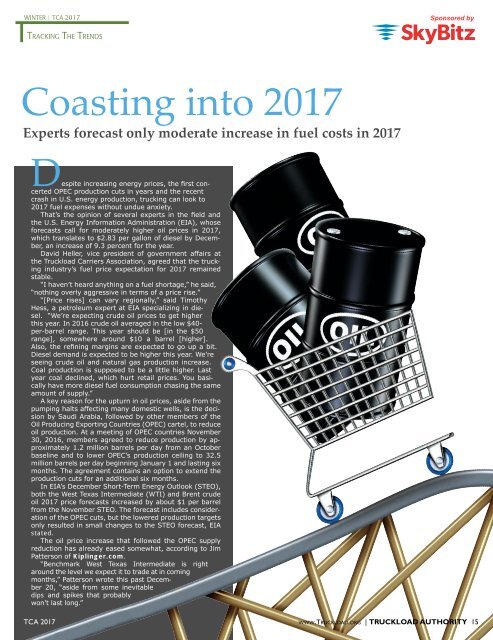TLA23_AllPages_R
You also want an ePaper? Increase the reach of your titles
YUMPU automatically turns print PDFs into web optimized ePapers that Google loves.
WINTER | TCA 2017<br />
Sponsored by<br />
Tracking The Trends<br />
Coasting into 2017<br />
Experts forecast only moderate increase in fuel costs in 2017<br />
Despite increasing energy prices, the first concerted<br />
OPEC production cuts in years and the recent<br />
crash in U.S. energy production, trucking can look to<br />
2017 fuel expenses without undue anxiety.<br />
That’s the opinion of several experts in the field and<br />
the U.S. Energy Information Administration (EIA), whose<br />
forecasts call for moderately higher oil prices in 2017,<br />
which translates to $2.83 per gallon of diesel by December,<br />
an increase of 9.3 percent for the year.<br />
David Heller, vice president of government affairs at<br />
the Truckload Carriers Association, agreed that the trucking<br />
industry’s fuel price expectation for 2017 remained<br />
stable.<br />
“I haven’t heard anything on a fuel shortage,” he said,<br />
“nothing overly aggressive in terms of a price rise.”<br />
“[Price rises] can vary regionally,” said Timothy<br />
Hess, a petroleum expert at EIA specializing in diesel.<br />
“We’re expecting crude oil prices to get higher<br />
this year. In 2016 crude oil averaged in the low $40-<br />
per-barrel range. This year should be [in the $50<br />
range], somewhere around $10 a barrel [higher].<br />
Also, the refining margins are expected to go up a bit.<br />
Diesel demand is expected to be higher this year. We’re<br />
seeing crude oil and natural gas production increase.<br />
Coal production is supposed to be a little higher. Last<br />
year coal declined, which hurt retail prices. You basically<br />
have more diesel fuel consumption chasing the same<br />
amount of supply.”<br />
A key reason for the upturn in oil prices, aside from the<br />
pumping halts affecting many domestic wells, is the decision<br />
by Saudi Arabia, followed by other members of the<br />
Oil Producing Exporting Countries (OPEC) cartel, to reduce<br />
oil production. At a meeting of OPEC countries November<br />
30, 2016, members agreed to reduce production by approximately<br />
1.2 million barrels per day from an October<br />
baseline and to lower OPEC’s production ceiling to 32.5<br />
million barrels per day beginning January 1 and lasting six<br />
months. The agreement contains an option to extend the<br />
production cuts for an additional six months.<br />
In EIA’s December Short-Term Energy Outlook (STEO),<br />
both the West Texas Intermediate (WTI) and Brent crude<br />
oil 2017 price forecasts increased by about $1 per barrel<br />
from the November STEO. The forecast includes consideration<br />
of the OPEC cuts, but the lowered production targets<br />
only resulted in small changes to the STEO forecast, EIA<br />
stated.<br />
The oil price increase that followed the OPEC supply<br />
reduction has already eased somewhat, according to Jim<br />
Patterson of Kiplinger.com.<br />
“Benchmark West Texas Intermediate is right<br />
around the level we expect it to trade at in coming<br />
months,” Patterson wrote this past December<br />
20, “aside from some inevitable<br />
dips and spikes that probably<br />
won’t last long.”<br />
TCA 2017 www.Truckload.org | Truckload Authority 15

















